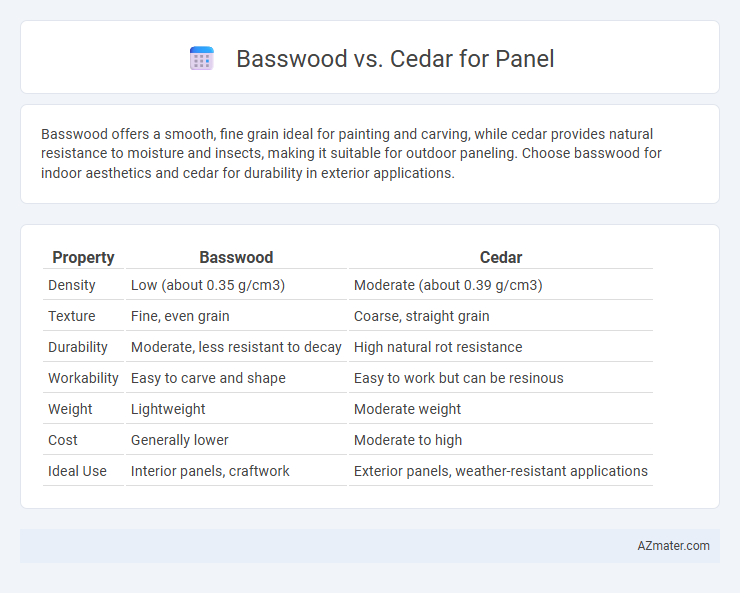Basswood offers a smooth, fine grain ideal for painting and carving, while cedar provides natural resistance to moisture and insects, making it suitable for outdoor paneling. Choose basswood for indoor aesthetics and cedar for durability in exterior applications.
Table of Comparison
| Property | Basswood | Cedar |
|---|---|---|
| Density | Low (about 0.35 g/cm3) | Moderate (about 0.39 g/cm3) |
| Texture | Fine, even grain | Coarse, straight grain |
| Durability | Moderate, less resistant to decay | High natural rot resistance |
| Workability | Easy to carve and shape | Easy to work but can be resinous |
| Weight | Lightweight | Moderate weight |
| Cost | Generally lower | Moderate to high |
| Ideal Use | Interior panels, craftwork | Exterior panels, weather-resistant applications |
Introduction to Basswood and Cedar Panels
Basswood panels are valued for their fine, even texture and lightweight softness, making them ideal for detailed carving and painting applications. Cedar panels offer natural resistance to decay and insect damage, featuring a distinct aromatic scent and rich reddish hue that enhances aesthetic appeal. Both woods provide versatile options for paneling, but basswood excels in smooth finishes while cedar is preferred for durability and outdoor use.
Botanical Characteristics of Basswood and Cedar
Basswood (Tilia spp.) features a light, creamy-white heartwood with fine, uniform texture and straight grain, known for its softness and excellent workability in panel applications. Cedar (Cedrus spp.), by contrast, exhibits aromatic, reddish-brown to pale yellow heartwood with natural oils that provide durability and resistance to decay and insects, making it ideal for outdoor paneling. Both species belong to distinct botanical families--Basswood in Malvaceae and Cedar in Pinaceae--reflecting their differing cellular structures and growth patterns that influence panel performance.
Appearance and Grain Comparison
Basswood features a pale, creamy color with a fine, uniform grain that creates a smooth, subtle texture ideal for painting or carving. Cedar displays a richer reddish-brown hue with pronounced, straight grain patterns and occasional knots, offering a rustic and natural aesthetic. The choice between Basswood and Cedar panels depends on whether a clean, refined look or a warm, character-rich appearance is preferred.
Durability and Resistance Properties
Basswood offers moderate durability with a fine, even texture but has lower natural resistance to decay and insects, making it better suited for indoor paneling in controlled environments. Cedar is highly durable and naturally resistant to rot, moisture, and insect damage, making it ideal for exterior panels or areas exposed to humidity and varying weather conditions. The natural oils in cedar enhance its longevity, whereas basswood requires protective finishes to improve its resistance properties.
Workability and Ease of Use
Basswood offers exceptional workability due to its soft texture and fine, even grain, making it ideal for detailed paneling and easy to shape with hand or power tools. Cedar, while slightly harder, provides natural resistance to decay and insect damage, making it easier to maintain in outdoor panel applications but requiring sharper tools for precise cuts. Both woods carve cleanly, but basswood's smoother surface reduces splintering, enhancing ease of use for intricate interior panel designs.
Acoustic Qualities of Basswood vs Cedar
Basswood offers excellent acoustic properties due to its lightweight and fine grain, providing warm, balanced tones with good resonance and clarity, making it ideal for musical instrument panels and soundproofing applications. Cedar, known for its soft texture and natural oils, delivers a rich, warm sound with strong mid and low frequencies, favored for its natural ability to dampen vibrations and reduce echo in acoustic panels. Both woods enhance acoustic performance, with basswood excelling in clarity and responsiveness, while cedar excels in warmth and vibration control.
Environmental Impact and Sustainability
Basswood offers a lower environmental impact due to its faster growth rate and sustainable harvesting practices, making it an eco-friendly choice for paneling. Cedar, while naturally resistant to decay and insects, grows more slowly and may contribute to greater deforestation concerns if not sourced responsibly. Choosing FSC-certified basswood or cedar ensures sustainable forest management and reduced carbon footprint for panel applications.
Cost Differences and Value
Basswood panels typically cost more than cedar due to their finer grain and smoother finish, which enhances aesthetic appeal and ease of painting. Cedar offers greater natural resistance to decay and insect damage, translating into longer-lasting value for outdoor applications despite its lower initial price. Evaluating cost differences, basswood provides superior workability for detailed interior projects, while cedar balances affordability and durability for exterior paneling.
Best Use Cases for Each Wood Type
Basswood excels in applications requiring lightweight, smooth surfaces ideal for detailed carving, making it perfect for decorative wall panels and intricate cabinetry. Cedar offers superior natural resistance to moisture and decay, making it the preferred choice for exterior panels, siding, and environments exposed to weather. Both woods serve distinct purposes; basswood is favored indoors for fine craftsmanship, while cedar is optimal for durable, weather-resistant outdoor installations.
Final Verdict: Choosing the Right Wood for Panels
Basswood offers a smooth, fine grain ideal for detailed carving and painting on panels, while cedar provides natural resistance to moisture and decay, making it suitable for outdoor use. For interior panels where a clean finish and easy workability are priorities, basswood is the preferred choice. Cedar excels in durability and weather resistance, making it the best option for exterior paneling or areas exposed to humidity.

Infographic: Basswood vs Cedar for Panel
 azmater.com
azmater.com